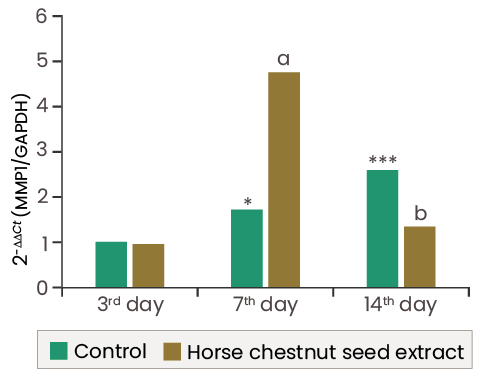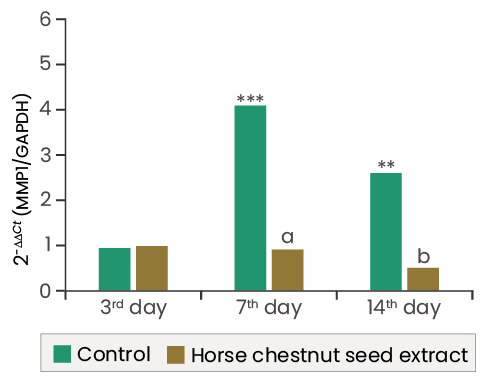Study 1
Horse chestnut extract was evaluated for its ability to accelerate wound healing in diabetic preclinical models. The study, along with evaluating the visual changes in the wound, also evaluated the effect of the extract on the expression of key tissue structures maintaining enzymes (matrix metalloprotease (MMP)-1 and MMP-9), on the activity of myeloperoxidase (MPO), and on the levels of hydroxyproline and malondialdehyde (MDA) in the wound tissue. The results indicated that the application of the extract ointment (15% w/w) increased the hydroxyproline level, decreased the levels of MDA, the activity of MPO, and the expression levels of MMP‐1 and MMP‐9 genes (Fig. 5). The observations show that the exract accelerated the cutaneous wound‐healing process in diabetic conditions via MMP‐1 and MMP‐9 regulation.

seed extract treated wound tissue
(*p < 0.05, ***p < 0.001 compared to the 3rd day control group,
ap < 0.001 compared to the 7th day control group,
bp < 0.01 compared to the 14th day control group).

seed extract treated wound tissue
(**p < 0.01, ***p < 0.001 compared to the 3rd day control group,
ap < 0.001 compared to the 7th day control group,
bp < 0.05 compared to the 14th day control group).
Figure 5. Effect of the extract on the expression of MMP-1 and MMP-9 in wound tissue
Reference
Ksoy H, Çevik Ö, Şen A, Göğer F, Şekerler T, Şener A. Effect of Horse-chestnut seed extract on matrix metalloproteinase-1 and -9 during diabetic wound healing. J Food Biochem. 2019;43(3): e12758.